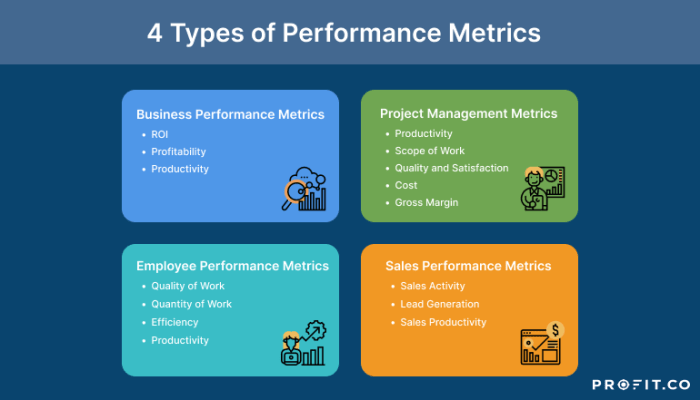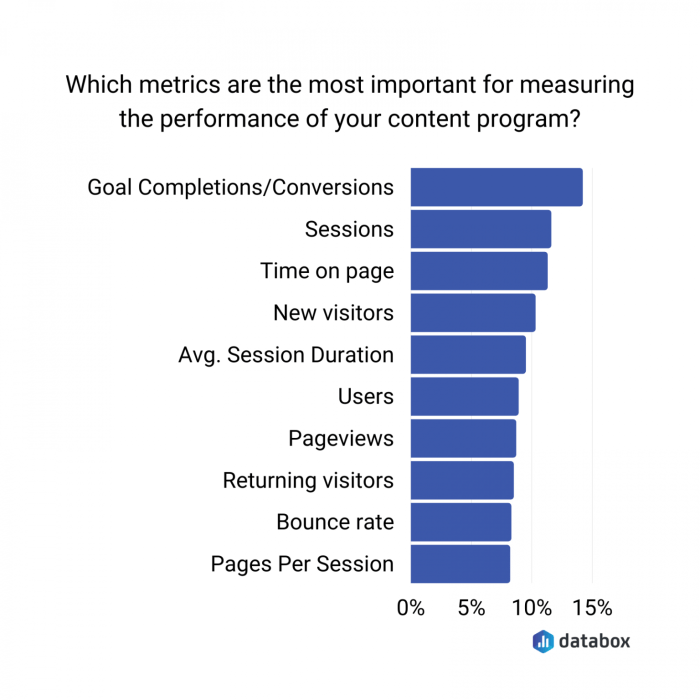Understanding Content Performance Metrics is like cracking the code to digital success, where every click and view tells a story of your online presence. Get ready to dive into the world of metrics that shape your content strategy and elevate your brand!
In this exciting journey, we will explore the different types of content performance metrics, tools to measure them, interpreting the data, overcoming challenges, and ultimately, optimizing your content strategy for maximum impact.
Introduction to Content Performance Metrics
Content performance metrics are key indicators that help measure the effectiveness of your content in achieving its goals. These metrics provide insights into how well your content is resonating with your audience and how it is contributing to your overall marketing strategy.
Tracking content performance metrics is essential for understanding what is working and what needs improvement in your content strategy. By analyzing these metrics, you can identify trends, optimize your content, and make data-driven decisions to drive better results.
Common Content Performance Metrics
- Page Views: The number of times a page is viewed by users. This metric helps to gauge the popularity of your content.
- Unique Visitors: The number of individual users who visit your content. This metric indicates the reach of your content.
- Click-Through Rate (CTR): The percentage of users who click on a link or call-to-action within your content. This metric measures the effectiveness of your content in driving actions.
- Conversion Rate: The percentage of users who complete a desired action, such as making a purchase or signing up for a newsletter. This metric shows how successful your content is in achieving its goals.
- Bounce Rate: The percentage of users who leave your site after viewing only one page. A high bounce rate may indicate that your content is not engaging or relevant to your audience.
Types of Content Performance Metrics: Understanding Content Performance Metrics
When it comes to measuring the success of your content, there are various types of metrics you can track. These metrics fall into different categories, each providing valuable insights into how your content is performing and where improvements can be made.
Engagement Metrics
Engagement metrics focus on how users interact with your content. Examples of engagement metrics include:
- Pageviews: The number of times a page is viewed by users.
- Average Time on Page: The average amount of time users spend on a page.
- Click-Through Rate (CTR): The percentage of users who click on a link or call to action.
Engagement metrics help you understand how users are interacting with your content and whether it is resonating with your audience.
Conversion Metrics
Conversion metrics measure how well your content is driving desired actions from users. Examples of conversion metrics include:
- Conversion Rate: The percentage of users who take a specific action, such as making a purchase or signing up for a newsletter.
- Lead Generation: The number of leads generated through your content.
- Return on Investment (ROI): The revenue generated compared to the cost of creating and promoting the content.
Conversion metrics are crucial for evaluating the effectiveness of your content in driving valuable actions from your audience.
Metrics
metrics focus on how well your content is optimized for search engines. Examples of metrics include:
- Rankings: The position of your content in search engine results for specific s.
- Organic Traffic: The number of visitors who find your content through organic search results.
- Backlink Profile: The number and quality of external websites linking to your content.
metrics help you assess how well your content is performing in search engine results and identify areas for improvement to increase visibility and traffic.
Tools for Measuring Content Performance Metrics

When it comes to tracking and analyzing content performance metrics, there are several popular tools that are widely used in the industry. These tools provide valuable insights into how your content is performing and help you make informed decisions to optimize your content strategy.
Google Analytics
Google Analytics is one of the most widely used tools for measuring content performance metrics. It provides detailed data on website traffic, user behavior, and conversions. With Google Analytics, you can track metrics such as page views, bounce rate, time on page, and more. The platform also offers advanced features like goal tracking, audience segmentation, and e-commerce tracking.
SEMrush
SEMrush is another powerful tool for measuring content performance metrics. It offers a comprehensive suite of tools for , PPC, content marketing, and social media. With SEMrush, you can analyze your website’s performance, track rankings, conduct competitive analysis, and identify opportunities for improvement. The platform also provides detailed insights into backlinks, organic traffic, and more.
Moz
Moz is a popular tool among professionals for measuring content performance metrics. It offers tools for research, link building, site audits, and rank tracking. Moz’s content performance metrics help you monitor the effectiveness of your content strategy and identify areas for improvement. The platform also offers valuable insights into domain authority, page authority, and spam score.
Tips for Selecting the Right Tool
When choosing a tool for measuring content performance metrics, it’s important to consider your specific needs and goals. Here are some tips to help you select the right tool:
- Identify your key metrics: Determine which metrics are most important for your content strategy, such as traffic, engagement, conversions, or ROI.
- Consider your budget: Evaluate the cost of each tool and choose one that fits within your budget while still meeting your requirements.
- Ease of use: Look for a tool that is user-friendly and provides intuitive dashboards and reports for easy analysis.
- Integration capabilities: Consider whether the tool integrates with other platforms and tools you are already using to streamline your workflow.
- Customer support: Check the level of customer support provided by the tool’s vendor to ensure you have access to assistance when needed.
Interpreting Content Performance Metrics
When it comes to analyzing content performance metrics, it’s essential to understand key indicators like bounce rate, click-through rate, and conversion rate to make informed decisions about your content strategy.
Bounce Rate
The bounce rate measures the percentage of visitors who navigate away from your site after viewing only one page. A high bounce rate may indicate that your content is not engaging enough or that it doesn’t align with visitor expectations. On the other hand, a low bounce rate suggests that visitors are finding your content relevant and are exploring further.
Click-Through Rate
The click-through rate (CTR) measures the percentage of users who click on a specific link compared to the total number of users who viewed the page. A high CTR indicates that your content is compelling and encourages users to take action. It’s crucial to analyze CTR to understand how effective your calls-to-action are in driving user engagement.
Conversion Rate, Understanding Content Performance Metrics
The conversion rate measures the percentage of visitors who complete a desired action, such as making a purchase or signing up for a newsletter. A high conversion rate indicates that your content is successfully guiding users through the conversion funnel. By analyzing conversion rates, you can identify areas for improvement in your content strategy to drive more conversions.
Interpreting these key content performance metrics allows you to gain valuable insights into the effectiveness of your content strategy and make data-driven decisions for optimization. By monitoring trends and patterns in metric analysis, you can identify areas of improvement and adjust your content strategy accordingly to better engage your audience and achieve your goals.
For example, if you notice a high bounce rate on a particular landing page, you can analyze the content and layout to make it more engaging and relevant to visitors. Similarly, if you observe a low conversion rate on a product page, you can optimize the call-to-action buttons or product descriptions to encourage more conversions. By leveraging insights from content performance metrics, you can continuously refine your content strategy to enhance user experience and drive better results.
Challenges in Understanding Content Performance Metrics

Interpreting content performance metrics can be challenging for marketers due to various factors that may impact the accuracy of the data. It is crucial to identify and address these challenges to make informed decisions and optimize content strategy.
Common Challenges in Interpreting Content Performance Metrics
- Overreliance on Vanity Metrics: Marketers often focus on vanity metrics like page views or likes, which may not provide meaningful insights into content effectiveness.
- Data Overload: With numerous metrics available, marketers may struggle to prioritize and analyze the most relevant data for decision-making.
- Lack of Context: Metrics alone may not provide a clear picture of performance without considering the context of the content, audience, or industry trends.
- Inconsistent Measurement: Inaccurate tracking or inconsistent measurement methodologies can lead to misleading interpretations of content performance.
Strategies for Overcoming Challenges
- Define Clear Goals: Establish specific goals and key performance indicators (KPIs) to align metrics with desired outcomes and focus on relevant data.
- Utilize Comprehensive Analytics Tools: Invest in robust analytics tools that provide in-depth insights and customizable reports to track performance effectively.
- Regularly Review and Refine Metrics: Continuously evaluate metrics based on changing objectives and adjust strategies to improve content performance.
- Seek Expert Guidance: Consult with data analysts or industry experts to gain a deeper understanding of complex metrics and enhance interpretation skills.
Impact of Inaccurate Interpretation on Decision-Making
Misinterpreting content performance metrics can have significant consequences on decision-making processes, leading to suboptimal strategies and ineffective campaigns. Without accurate insights, marketers may allocate resources inefficiently, miss opportunities for optimization, or fail to meet business objectives. It is essential to address challenges in interpreting metrics to make data-driven decisions and drive successful outcomes.
